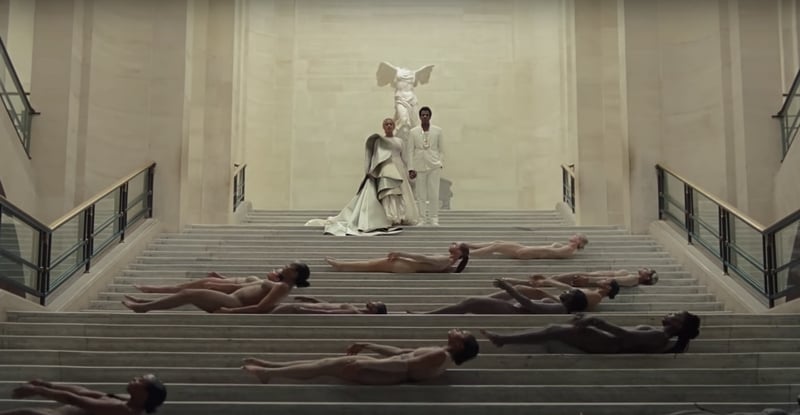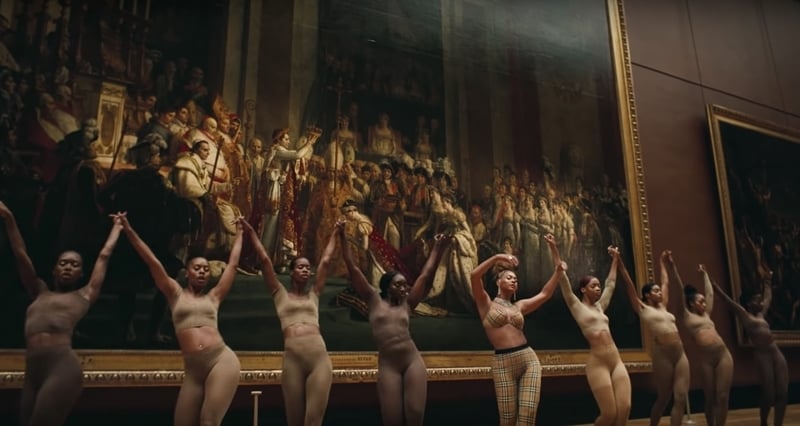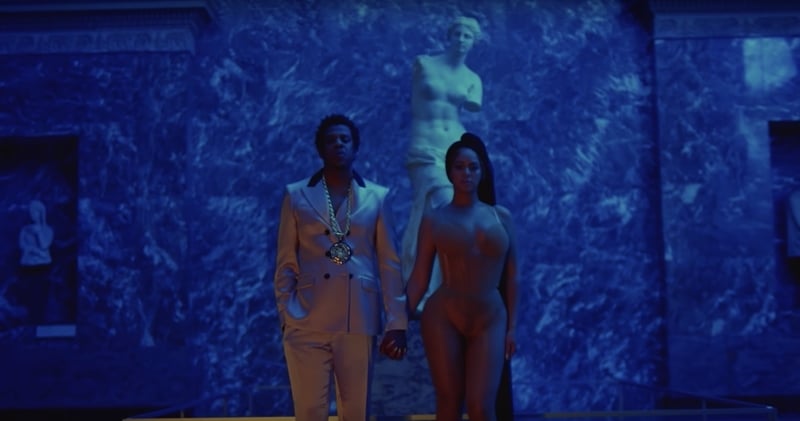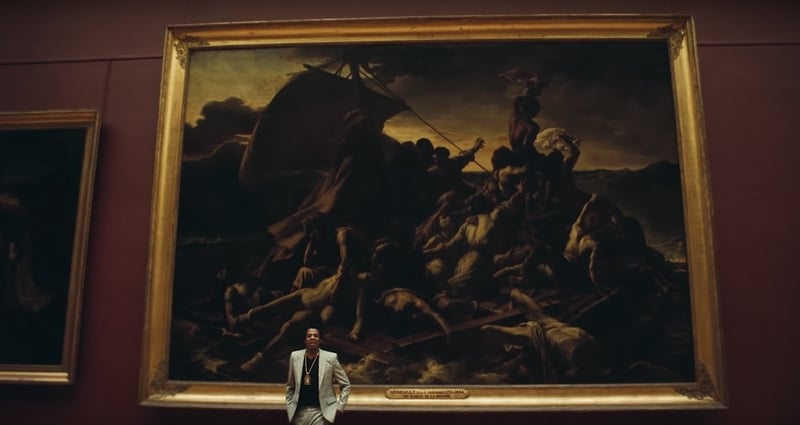Not a fan of dusty pictures hanging off walls? Well, with the release of their absolutely epic music video for the equally #lit track, “Apes***”, the Carters (that is, the Beyoncé and Jay-Z, mind you) might just have you clamouring for a ticket to visit the famed Louvre in Paris.
Surely, sculptures and paintings have never looked quite so fresh, or felt quite so relevant, than in this powerful music video staging a pointed intervention in Western art and history. Indeed, the Louvre, a perennial symbol of the wealth and power France has accumulated through its colonial past, becomes a location for a subversive celebration of black excellence.
We understand that art might prove intimidating for some, so we present here a generalist’s capsule guide to some of the major artworks that appeared in the video, alongside a couple of reasons why the Carters might have chosen them.
After this art lesson taught by Beyoncé and Jay-Z, you’ll be equipped with all the information you need to take on the sprawling Louvre and its iconic exhibits. Have tons of fun — and remember to go apes**** in the Louvre!
1. Mona Lisa (1503) — Leonardo da Vinci

Ah, the Mona Lisa, a.k.a. the top (often the only) reason cited for a visit to the Louvre. But only if you’re also prepared, however, to jostle with hundreds of tourists all desperate for a selfie with the enigmatic lady protected behind bulletproof glass.

Which is why a shot of the room emptied of tourists is a corresponding measure of the wealth and power the Carters wield as the reigning duo of the American music industry. Standing unsmiling before the painting, they also force us to consider them as subjects worthy of great portraitures, like the Mona Lisa herself.
In a (white) history of art that has chosen to erase the presence of black bodies, their intrusion here is pronounced, and made even more acute when they turn to look at the painting as we do — only this time, with our acknowledgement of their power as consumers of art.
The Mona Lisa is located in Room 711, 1st Floor, Denon Wing.
2. Winged Victory of Samothrace (2nd century B.C.E.)

Image credit: YouTube
Look at the gorgeous folds on Beyoncé’s dress. Then look at the drapings on the sculpture. If anything, the comparison attests to the consummate skill of the unknown sculptor behind the Winged Victory, considering that the statue is made of marble. Yes, delicate drapery carved entirely out of solid marble. For a closer examination, you’ll just have to visit the Louvre.
Symbolising victory in warfare, the statue also allies the female form with traditionally masculine traits: strength and honour in battle. The visual association between Beyoncé and the Winged Victory then further casts the pop singer as a contemporary image of success. Standing atop the staircase, Beyoncé strikes an imposing figure while bestowing power on the women that lay before her.

It is no wonder then, that the Winged Victory is a recurrent motif in the video. Near the end of the video, however, Beyoncé breaks her initial poise and regality to thrash wildly before the statue. A manic unleashing of uncontainable power? You decide.
The Winged Victory of Samothrace is located along the Victory of Samothrace staircase, Ground Floor, Denon Wing.
3. The Consecration of the Emperor Napoleon… (1807) — Jacques-Louis David

Image credit: YouTube
This Neoclassical piece of political propaganda is a picture of appropriated power: Napoleon has just taken the crown from the Pope and is about to crown either himself (as the original sketch suggests), or his Empress Joséphine.

Napoleon defied religious authority by taking on the Pope’s role at the coronation. By comparison, Beyoncé and her army of black women dancing here suggests another act of defiance. Indifferent to the monumental scale of the picture behind them, it is Beyoncé who appropriates the painting’s power to crown herself queen.
Considering that Napoleon was a major coloniser of Northern Africa in the early 19th century, the picture of (stolen) power Beyoncé paints here (all puns intended) becomes even more arresting.
The Consecration of the Emperor Napoleon and the Coronation of the Empress Joséphine on December 2, 1804 is located in Room 702, 1st Floor, Denon Wing.
4. Venus de Milo (130-100 B.C.E.)

Image credit: YouTube
Beyoncé has always been interested in Aphrodite (the Greek goddess of love and beauty) — remember those baby announcement photos? Just as with the Winged Victory, Beyoncé’s bodysuit and ‘S’ pose visually associates herself with the statue of the goddess and its idealised form of beauty. The difference being, of course, that ideal beauty can be embodied within a black woman as well.

As with the Winged Victory again, Beyoncé here transits from a picture of composed regality with her husband to languid dancing in front of the statue. Clearly, she concentrates in her body images of marital love and its evocatively physical and sensual aspects. In other words, she presents herself as our modern-day Black Venus.
The Venus de Milo is located in Room 346, Ground Floor, Sully Wing.
5. The Raft of the Medusa (1818-1819) — Théodore Géricault

Jay-Z gets in on some art action too while spitting verses in front of Géricault’s looming masterpiece. Based on true events, the canvas depicts survivors of the French frigate Méduse after it ran aground while on a colonising mission to Senegal in 1816. Of the 150 crew members who set sail, only ten survived, after 13 harrowing days filled with brutality and even cannibalism.

Image credit: YouTube
A melancholy picture of mocked hope and sheer desperation, it is perhaps strange for Jay-Z to be filmed smiling in front of the painting while telling the “Grammy’s f*** that 0-to-8 s*** / Have you ever seen a crowd going apes***?”.
But perhaps that’s the whole point of the juxtaposition. Although Jay-Z wins none of the eight Grammys he was nominated for, he turns his mocked hope into a gesture of assured dismissal, proclaiming that he doesn’t need awards to have an entire stadium screaming and shouting his name.
The Raft of the Medusa is located in Room 700, 1st Floor, Denon Wing.
This tantalising taster showcases only five of the numerous works that appear throughout the music video. But if it has whet your appetite for even more fabulous art, we highly recommend that you check them out in person, if only to experience the sheer power they exercise on viewers. If you’d like to see them on a guided tour, the Louvre has recently begun offering a 90-minute visitor trail on four days a week — although, for now, the tour seems to be conducted only in French.
In all, “Apes***” show us that museums are more than just places made for the exclusive enjoyment of the rich or sophisticated. In this felicitous marriage of pop culture and art history, Beyoncé and Jay-Z have made the Louvre and its collection more pertinent than ever.
Indeed, even a cursory understanding of each work enhances our appreciation of the larger narrative the Carters are telling through their own art: it is a powerful statement of cultural, political and historical triumph for the African-American community. Charged with such urgent sentiments, a visit to the Louvre can only accentuate the renewed political purchase these works have gained with the Carters and us.
Easily accessible by the Paris Métro at the station Palais-Royal Musée du Louvre, the Louvre is open every day of the week, except Tuesday. There are extended opening hours on Wednesdays and Fridays.
Admission cost €15. Online tickets can be purchased at €17, and allows you quicker access to the museum.
Admission is free every first Sunday of the month, from October to March.
Admission is free for under-26s of any nationality on Fridays after 6pm.




